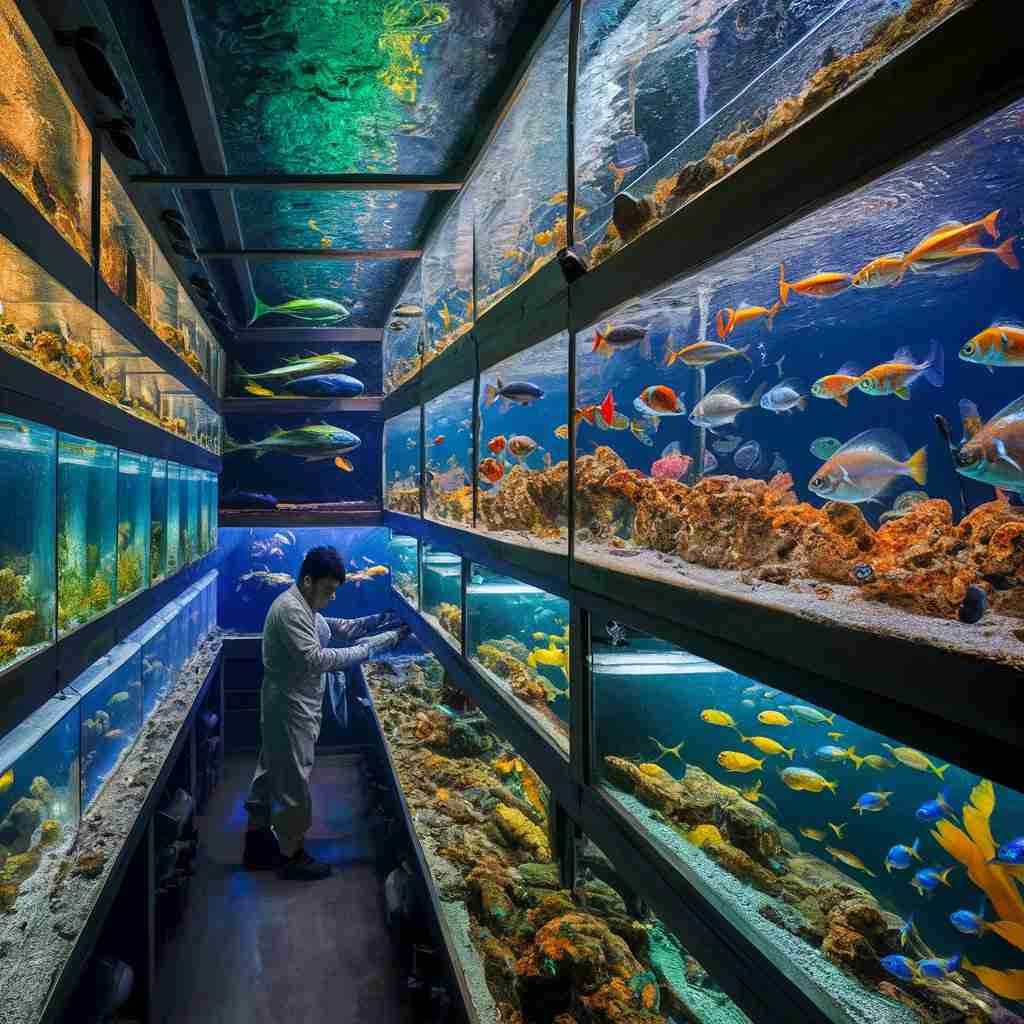Fish breeding is the controlled process of encouraging fish to reproduce under ideal conditions in order to generate offspring with desired characteristics. This includes selecting parent fish based on qualities such as growth rate and disease resistance, generating appropriate spawning and egg fertilization settings, and carefully regulating egg and larvae development. Fish breeding, whether done naturally in ponds and rivers or artificially using hormone induction and controlled settings, is critical in aquaculture because it ensures the sustainability and quality of fish stocks for commercial, recreational, and conservation purposes.
Table of Contents
Basic Principles of Fish Breeding

Fish breeding is the controlled reproduction of fish to generate progeny with desirable characteristics. Basic principles of fish breeding include:
- Selection: Choosing parent fish with desirable characteristics including development rate, illness resistance, and environmental adaptability.
- Mating: Ensure proper pairing or grouping of selected fish for successful fertilization.
- Spawning: Creating optimal circumstances for egg laying and fertilization, which frequently requires certain water temperatures, substrates, and lighting conditions.
- Incubation: Providing ideal circumstances for egg development, including adequate water quality and temperature.
- Hatching: Providing a suitable environment for larvae to emerge from their eggs and begin feeding.
Breeding of Common Carp
The breeding of common carp (Cyprinus carpio) requires a complete understanding of their environmental and physiological requirements. Maintaining ideal water temperatures ranging from 18°C to 24°C is critical for effective spawning. The selection of spawning substrates is also important, with aquatic vegetation or synthetic materials like as nylon ropes being utilized to simulate natural breeding habitats. These substrates provide a surface on which the eggs can attach and develop.
Hormone injections are commonly used to induce breeding in common carp aquaculture. This procedure involves providing hormones like human chorionic gonadotropin (HCG) or carp pituitary extract to enhance ovulation and sperm production. The procedure begins with the selection of healthy broodstock, which are normally 2-4 years old, in good health, and free of disease. The chosen broodstock are then administered with the proper hormone dose according on their body weight and carefully watched for responses.
Several issues may emerge during the breeding process, including as poor responsiveness to hormone injections, fungal infections on eggs, and poor water quality. Overcoming these issues entails keeping the broodstock in good health, maintaining pristine water conditions, and administering antifungal treatments as needed. Regular monitoring and changes are required to address these concerns and maintain healthy fry development.
Finally, selecting and maintaining healthy broodstock is essential for successful breeding. This includes frequent health checks, a nutritious food, and a stress-free atmosphere. Proper broodstock management not only improves reproductive performance but also helps to ensure the overall success of common carp breeding programs.
Breeding of Chinese Carps and Indigenous Major Carps
Breeding Chinese carps such grass carp, silver carp, and bighead carp, as well as indigenous major carps like rohu, catla, and mrigal, necessitates specialized approaches that are specific to each species’ biology. These species have distinct reproductive tendencies, demanding a thorough grasp of their individual breeding requirements.
Environmental factors influence the breeding success of both Chinese and indigenous large carps. Optimal water quality is critical, with a preference for clean, oxygenated water. Chinese carps normally spawn between 20°C and 28°C, but indigenous major carps flourish between 24°C and 30°C. Furthermore, appropriate spawning substrates, such as aquatic vegetation or artificial spawning mats, are required to simulate natural breeding settings.
Induced breeding is a frequent method used to increase spawning in these carps. Hormone injections, such as human chorionic gonadotropin (HCG) or pituitary gland extract, are used to stimulate ovulation and spermiation. The time and dosage of hormone delivery are crucial and should be tailored to the species and environmental conditions. Once the fish are ready to spawn, they are moved to breeding tanks with ideal circumstances.
Egg collection and hatching are critical processes after successful spawning. Chinese carp eggs are generally sticky and must be carefully removed from the spawning substrate. In contrast, eggs from indigenous major carps are semi-buoyant and can be caught with fine mesh nets.
Fish Seed Rearing and Transportation
Fish seed rearing is an important step in the fish breeding process because it affects the survival and growth rates of fish larvae and fry. Maintaining high water quality is essential for growing fish larvae, which requires continuous monitoring of parameters such as temperature, pH, dissolved oxygen, and ammonia levels. Ensuring water quality is critical, as inadequate circumstances can result in high mortality rates and stunting growth.
Feeding regimens are also important for the effective growth of fish seed. It is critical to offer a balanced diet that meets the nutritional needs of the larvae and fry. This usually consists of a mix of live feeds, such as rotifers and Artemia, and formulated meals that provide the necessary proteins, lipids, vitamins, and minerals.
Disease management is another important part of fish seed production. Regular health exams and preventative medicines can assist to prevent illness outbreaks. Maintaining a clean and hygienic rearing environment, as well as using quarantine measures on new stock, can help to limit the risk of disease transmission.
Monitoring growth rates and health indicators is critical during the rearing phase. This entails regular sampling and measuring of fish in order to track their development and detect any problems early on. Consistent development and good health are markers of successful raising procedures.
Transportation of fish seed necessitates meticulous preparation and execution to ensure the fish’s safety and well-being. Packaging strategies, such as using oxygenated water and insulated containers, are crucial for ensuring proper temperature and oxygen levels during travel. Temperature regulation is critical since changes can create stress and increase susceptibility to disease.
To reduce stress during transit, handle the fish carefully and limit the time spent out of the water. To avoid shock, adapt the fish to new water conditions gradually when they arrive. Maintaining consistent climatic conditions and avoiding physical damage are among the challenges of transporting fish seeds. Strategies for mitigating these concerns include using specialized transport trucks, constantly monitoring environmental factors, and using competent staff to handle the fish.
Effective fish breeding entails knowing the reproductive biology of target species, providing ideal breeding circumstances, and assuring offspring health and viability through careful seed nurturing and shipping techniques. Aquaculturists who understand these ideas and approaches can improve fish productivity and sustainability.
Frequently Asked Question(FAQ)
What is fish breeding?
Fish breeding is the controlled process of encouraging fish to reproduce under specific conditions in order to create offspring with desirable characteristics such as growth rate, disease resistance, and coloration.
What are common challenges in fish breeding?
Disease outbreaks, low egg fertilization rates, genetic abnormalities, and maintaining appropriate water and environmental conditions are all common issues in fish breeding.
Related Articles

